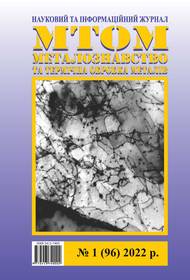DEVELOPMENT AND IMPLEMENTATION OF A NEW METHOD FOR MODELING PHASE-STRUCTURAL TRANSFORMATIONS DURING COOLING OF ALLOY STEELS
DOI:
https://doi.org/10.30838/J.PMHTM.2413.240422.17.838Keywords:
physicochemical modeling, phase transformation, alloy steels, cooling, nonequilibrium thermodynamics, structural diagramsAbstract
Formulation of the problem. Modern research on the phase transformations modeling in low-alloy steels allow solving the problem of phase transformations quantitative determination for a given chemical composition of steel and different cooling rates. However, the possibilities of available universal software products for the complex alloy steels analysis are limited. The impossibility for users to integrate their own subroutines according to the phase transformation diagrams is their main disadvantage. Purpose of research. Modeling phase-structural transformations during cooling of complex-alloy steels taking into account the formation of all structural components, in particular residual austenite. To research, steels 25Cr2Mo1V and 38CrNi3MoV and existing analytical models were used, which were adapted to carry out the relevant calculations. Results. A new method for modeling phase-structural transformations during cooling of alloy steels is developed. Structural diagrams depending on the rate of continuous cooling are constructed for the investigated steels. For the first time, the amount of residual austenite is taken into account according to the developed method. Under developed method thermokinetic diagrams of investigated steels austenite transformation are constructed. According to the diagrams, the decay of austenite steel 38CrNi3MoV begins at lower temperatures compared to steel 25Cr2Mo1V. Steel 25Cr2Mo1V, with continuous cooling at a rate of 1.0 °C/s (conditions close to natural air cooling), consists of 18 % ferrite, 1 % pearlite, 80 % bainite and 1 % residual austenite. Steel 38CrNi3MoV cooled at a rate of 1,0 °C/s consists of 2 % ferrite, 47,5 % bainite, 50 % martensite and 0,5 % residual austenite. It is shown that the calculated data correlate well with practical results at the conditions of natural air cooling.

Downloads
Published
Issue
Section
License
Authors that are published in this journal agree to follow the conditions:
Authors reserve the right to the authorship of his work and cede the right to the journal of first publication of this work on conditions of the license under the Creative Commons Attribution License, which allows others to distribute it freely with the obligatory reference to the author of the original work and the first publication of the work in this journal.
